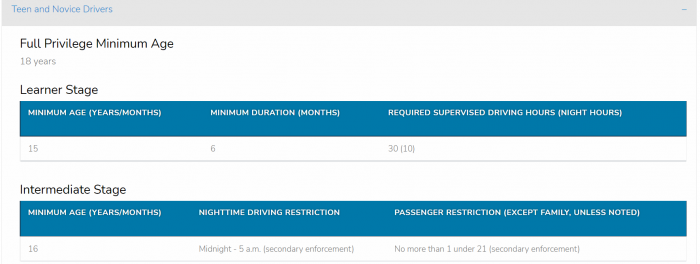For years you’ve dreaded this moment and have done your best to mentally prepare yourself to teach teach driver safety to your teen. The thought of your teenager sitting behind the wheel of one of the family’s most valuable assets probably makes you feel uncomfortable.
RELATED READING :: Precious Cargo – Traveling With Kids by Car
Driving a vehicle is a big responsibility and playing an active role in teaching your child how to drive safely is essential. According to the National Highway Traffic Safety Administration (NHTSA), car crashes are the leading cause in deaths for teens ages 16 to 17. Learning preventative measures and taking precautions will lower this risk significantly.
In preparation as you embark on your new venture as the passenger seat driver, there are some key things to know about driver safety that will make this experience less stressful and above all, a success.
THE TOPIC
10 Practical Driver Safety Tips

1. Be A Role Model
This is going to be a big pill to swallow. Bad driving habits are learned by a child’s parent(s). Demonstrating how to drive happened the moment YOU got behind the wheel with your child as a passenger.
The NHTSA cited a study done by Liberty Mutual and Students Against Destructive Decisions (SADD) found that parents are setting a bad example for teens by engaging in unsafe driving behaviors and even worse, don’t listen to their kids warnings. An alarming, 41% of teenagers admitted that their parents continue unsafe behavior, like texting while driving, and 28% of teens suggest that their parents justify their behavior. Sound familiar?
Talking to your teenager about making good driving decisions while actively correcting some bad judgement calls of your own is a wonderful start. They’ll respect you more if the rules of the road apply to both them and you. Remember, you are the biggest influence of your child driving safely on the road. Teens whose parents demonstrate good driving and implement constraints are less likely to engage in risky driving. As an aid, the CDC has created a contract, Parent-Teen Driving Agreement, that specifies exactly what your teen should be doing when they get behind the wheel.
2. Driver’s Education
Enrolling your child in driving lessons should not be a set-it-and-forget-it method. Driver’s ed should solely be viewed as a formal introduction to driving. You will need to be involved in assisting your child in obtaining driving hours that normally happen outside the classroom and reinforce things they learned. Practice makes perfect and this activity is no exception.
3. Graduated Driver’s Licensing (GDL) Law
More than likely your teen has reviewed this law in class, but as a parent it is your responsibility to enforce it. The law varies from state to state, but there are three stage restrictions put in place to protect novice drivers while driving on the road: Learner, Intermediate, and Full Privilege.

An individual with an Intermediate stage driver’s permit cannot drive after midnight, must be at least 16 years of age, and can have no more than 1 passenger under the age of 21 outside of family members in Texas. Violation of the law can result in a delayed or suspended license.
4. Vehicle Familiarity
Allowing your teenager to get comfortable with the vehicle they’re driving should be a priority in practicing driver safety. Teach them about every aspect of the car. Ensure they get in the habit to make the proper adjustments to the rear view and side mirrors, check all indications on the dashboard, adjust seating and, of course buckle up.
Beyond this, your teenager should also be familiar with what goes on under the hood and outside the cabin of the car.
Your teen should be able to:
- Pump gas
- Locate the battery as well as jumper cables to jump their vehicle in an emergency
- Find the oil and water caps
- Understand what routine maintenance looks like
- Know how to change a tire
Learning these things may seem arbitrary to a teenager only interested in getting behind the wheel, but the more they know the more self-sufficient they’ll be. These things are not demonstrated in detail in the driver’s education class.
Practicing routine instructions before starting the car will keep your young driver safe. Be sure they remember to:
- Scan the outside of the car for flat tires or defects
- Enter the car
- Connect phone to Bluetooth and place it out of reach
- Adjust seat and mirrors
- Fasten seat belt
- Inspect dashboard
- Unlock the emergency brake, if needed
- Start the car
5. Distractions
Minimizing distractions in the vehicle allow the driver to focus on what’s most important, the road. Listening to loud music and eating and drinking in the car are things that may divert your teens attention from the road. DPS research revealed that a teen is 6 times more likely to crash a car while dialing and 23 times more likely to get in an accident if they text.
The biggest distraction outside of talking and texting while driving is when your teen is driving with friends, which is why GDL Law has a passenger restriction on stages under Full Privileges.
6. Passengers
You may have done an amazing job of raising your child, but you can’t always control or anticipate the action of their peers. Be friendly with the parents of your child’s friends so can gauge if your driver safety house rules match up. Periodically discussing the agreement you outlined for your child will reinforce their responsibility. In all circumstances your teen should always be in control while driving.
A teenager is more likely to get in a car accident when they are driving with another teenager. While your teenager is learning how to drive you should create an environment that might be like what they’ll experience with friends. After your child is more confident try being more conversational and turn on the radio at a reasonable level.
7. Speeding
As teens are the most inexperienced with driving, they tend to speed over time as they grow confident on the road. When you are doing your practice rounds with your teen ask them, “What’s the speed limit?”, to confirm they are looking for the speed limit regularly as that can fluctuate. Review the speed limits that they should be driving in neighborhoods, near schools, and construction zones.
8. Seat belts
We’ve all watched the driving videos with the dummy launching forward through the window when not buckled in a seat belt. As horrible as it looks in class, many of us don’t always buckle up. We justify our actions by telling ourselves that we aren’t driving on the highway or pride ourselves in being safe drivers. Wearing a seat belt reduces death or injury in a car accident. The odds are that 1 in 107 people die from a motor-vehicle crash. This can be prevented when you take the time to advise your teen about how important it is to practice driver safety and buckle up.
9. Drowsy Driving
Nowadays, kids are often overwhelmed by the demands of homework, projects, and extracurricular activities from school. The stresses of wanting to get accepted into the best schools sometimes cuts into a child’s sleep time. Teens and young adults between the ages of 17 and 23 are more likely to combat sleep deprivation. When an individual is sleep deprived their ability to make rational decisions and react defensively or offensively on the road is delayed.
Giving your teenager curfews and teaching them the significance of recognizing their limits will better prepare them for situations outside of your control.
10. Drug & Alcohol Abuse
During these uncertain times it is imperative that you speak to your child about their mental health. Politics, academia, peer pressure, and the health safety of friends and family are major concerns for many that may affect your child more than you know.
If you haven’t already, please start asking your child how they’re coping with issues in their life and make sure your child feels comfortable speaking to you. The more open lines of communication are with your child the least likely it is they will engage in drug and alcohol abuse.
For parents who have kids on medication, your child should know that mixing drugs and alcohol can be lethal. The rise in opioid dependency is a public health emergency. If your child is having difficulty focusing at work or school let them know to never accept drugs from someone who is not a doctor.
More importantly, driving under the influence should never be an option.











